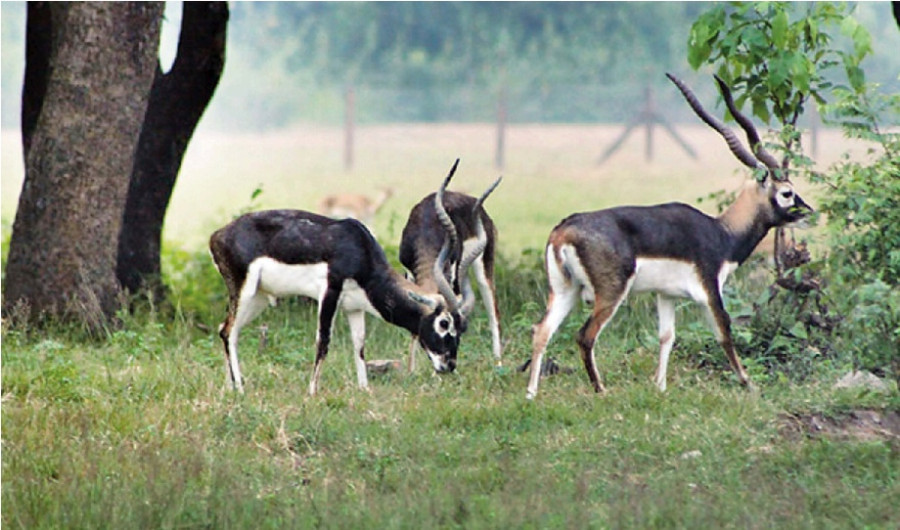Climate & Environment
Shuklaphanta park makes great strides in blackbuck conservation
The park has increased the blackbuck population to 113, but now there is a concern about limited space for the animals inside the park.
Chandan Kumar Mandal
In an encouraging development for wildlife conservation, Shuklaphanta National Park has outdone its target of achieving the blackbuck population target of 100 by 2020 by increasing the antelope numbers to 113, and that too with months still in hand for the year to end.
“We have not only managed to achieve the target but also double the blackbuck numbers from the time the animal was introduced to the park some eight years ago,” Laxman Prasad Poudyal, chief conservation officer of the park, told the Post.
The Shuklaphanta park has built a special sanctuary for blackbuck (Antilope cervicarpa), also locally known as Krishnasar, in Hirapur area.
The park had brought the first batch of 28 blackbucks—22 from Nepalgunj Mini Zoo and six from the Central Zoo in Lalitpur—on September 18, 2012. Another herd of 14 blacbucks were brought in July 2015 from Blackbuck Conservation Area in Bardiya.
These animals were kept in a predator-proof enclosed area built on 51 hectares of land in Hirapur Phanta. The blackbuck population stood at 89 in the fiscal year 2018-19.
“We have been rearing the blackbuck population within the enclosure that is now spread on 58 hectares of land. They have not been introduced in the wild yet,” said Poudyal.
Though these critically endangered species dwell and graze within the fenced off property, they are still at risk of getting attacked by dogs, jackals and leopards.
“Sometimes, local dogs enter the fenced area, and the park officials have to chase them away,” said Poudyal.
With the increasing population, there is now concern about the limited space available for blackbucks in the Hirapur area.
The Site-Specific Conservation Action Plan for Blackbuck in Shuklaphanta National Park (2016-2020) has envisaged releasing the blackbucks into the open area of the park when their population reaches a minimum of 100 individuals.
“Around one-hectare area is required for two blackbucks for their grazing and free movement. The individual population has already reached 113 and their dwelling area is limited to 58 hectares, which is not adequate,” said Poudyal. “We estimated their population to reach 200 by next year. The current area is adequate to hold the blackbucks and we do not have enough space for expansion.”
The blackbucks must either be released into the wild or translocated elsewhere. Releasing the blackbuck population inside the Shuklaphanta park, which has an area of only 305 sq km and adjoins farming areas and settlements, could pose a problem, though.
“The animal can come in contact with locals or damage their crops which can lead to human-wildlife conflict. The viable option is to translocate them to protected areas which have a vast area of forest, far away from human settlements,” said Poudyal. “For instance, Chitwan National Park or Koshi Tappu Wildlife Reserve could be considered as their new habitats for restocking their population.”
Blackbucks once roamed in the Tarai region, mainly in Kanchanpur, Bardiya and in the floodplains of the Rapti river in Banke. With the massive felling of forests and degradation of grassland, like other wildlife species, blackbuck population also dwindled drastically during the late 1950s and early 1960s due to habitat loss and poaching, according to the records of the Department of National Park and Wildlife Conservation.
By the early 1970s, the blackbuck was considered extinct in Nepal before the recording of nine individuals in 1975 in Khairapur of Bardiya gave hope for reviving its population in the country.
The Nepal government started its conservation and preservation of its natural population by declaring an area of 172 hectares in Khairapur, Bardiya as the Blackbuck Conservation Area in 2009.
The whole area was fenced to avert risk of disease transmission from livestock that grazed around the area. With the deployment of guards and years of continuous conservation efforts, the blackbuck population has rebound to around 300 individuals in Bardiya.
According to Haribhadra Acharya, a spokesperson with the department, the existing enclosure area of blackbuck can be expanded if there is a possibility.
“If there is not enough space, then these individuals can be translocated to parks like Bardiya or Chitwan,” Acharya, who is also an ecologist, told the Post. “Ultimately, we have to provide them wilderness. Once they are out of the enclosure, where they are also given subsidiary food, they do not need such supplements when left into the wild.”




 18.12°C Kathmandu
18.12°C Kathmandu











